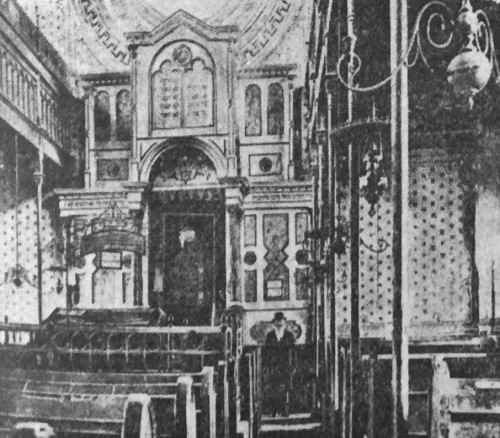 |
48°17' 21°27'
Translation of the “Tolscva” chapter from
Pinkas Hakehillot Hungary
Edited by: Theodore Lavi
Published by Yad Vashem
Published in Jerusalem, 1975
Our sincere appreciation to Yad Vashem
for permission to put this material on the JewishGen web site.
This is a translation from: Pinkas Hakehillot Hungary: Encyclopedia of Jewish Communities, Hungary,
Edited by Theodore Lavi, published by Yad Vashem, Jerusalem. Pages 308-309.
JewishGen, Inc. makes no representations regarding the accuracy of
the translation. The reader may wish to refer to the original material
for verification.
JewishGen is not responsible for inaccuracies or omissions in the original work and cannot rewrite or edit the text to correct inaccuracies and/or omissions.
Our mission is to produce a translation of the original work and we cannot verify the accuracy of statements or alter facts cited.
[Page 308]
Translated by Madeleine Isenberg
A town in the Zemplen Region, north of Tokaj (Tokay).
Population (1941): 2,845
Jewish Population
| Year | Population |
| 1723/24 | 24 |
| 1735 | 43 |
| 1771 | 54 (families) |
| 1812 | 84 |
| 1890 | 929 (individuals) |
| 1941 | 363 |
| 1946 | 52 |
| 1971 | 1 (family) |
Until the Second World War
The first preserved information we have about Tolcsva is from 1723. Seven Jewish families were then permitted, by the owners of the estate, to settle there as lessees of vineyards. They arrived there from Homonna[1] and nearby towns, and continued in the local production of wine that gained in reputation in the whole of Hungary. From the beginning of the 20th century and onward, an on–going decrease in the number of Jews in that place was felt.
Most of the Jews of Tolcsva were either merchants or winegrowers, among them wine–producers. A few were small producers (of spices, wood) and members of the free professions, craftsmen, and carters.
The relations between the residents and the local Jews was generally fine, and many even sent their children to learn in the Jewish schools.
With the split of the Hungarian Jewish Communities, Tolcsva defined itself as Orthodox and subordinate it were the settlements of Komlóska, Bodrogolaszi, Zsadány, Felsöhuta, Középhuta, and Alsóhuta.
The Chevra Kadisha (burial society) was established in 1770. Other welfare organizations were “Poel Tzedek” (a charitable trust) and the women's organization.
The synagogue that was built around 1860, went up in fire in 1864. Even the synagogue that replaced it was burnt, but they successfully restored it.
Until 1865 they had a six–year school with four teachers, however under the influence of the rabbi of nearby Szikszó, secular studies were cancelled, and then the school became a cheder (young children's religious school) and alongside it a yeshiva (Talmudic seminary) was established.
|
|
| Synagogue Interior |
[Page 309]
|
|
| The Synagogue |
Most of the kehilla's (community's) institutions – the Chevra Kadisha, yeshiva, Poel Tzedek, and the kehilla's officers resided in buildings that belonged to the kehila.
Among the rabbis of Tolcsva, we note:
Rabbi Moshe David[2] (at the beginning of the 19th century) who was referred to in the responsa of the “Chatam Sofer.”
Rabbi Aharon GRÜNBERG (1811–1893), author of “Da'at Sofer[3]” (The Scribe's Knowledge) who was later called to the rabbinate in Nagymihály.
Rabbi Yitzchak GLÜCK[4] (1859–1909), who was known as an outstanding scholar, author of “Yad Yitzchak[5]” (Isaac's Hand) and “Be'er Yitzchak ” (Isaac's Well).
After him, Rabbi Shmuel GOTTLIEB served as rabbi, and who in 1925 moved to become the rabbi in Papa.
The last of the Tolcsva rabbis was Akiva KORNITZER (1928–1944) who perished in the Holocaust.
|
|
| Rabbi Shmuel GOTTLIEB |
Between the two world wars, a cultural center was established that conducted theatrical plays and there were considerable Zionist activities.
With the publication of the discriminatory laws in 1938, relationships toward Jews changed from extreme to another. Their property and vineyards were expropriated, and little by little, their businesses as well.
The Holocaust Period
In 1941, a few families were arrested because they did not have citizenship papers, and taken to Kamenec–Podolsk, and shot there. In 1942, the young men were taken for forced labor, sent to the Ukraine, and most perished.
On 19 March 1944, all the Jews of Tolcsva were taken to Sátoraljaújhely and from there were transported to Auschwitz.
After the war about 40 people returned, half of whom were from the forced labor and the rest from Auschwitz, mainly women. They found the synagogue still in good shape, but of the 20 Torah scrolls, not one was left. They renewed the community life that in 1949 numbered about 50 souls. However, the survivors could not take it for long; most emigrated to Israel. The synagogue was sold, and in 1970 only one family remained there.
Y.K.
References:
Yad Vashem Archives, E–7–4/61; E–7–4/66/
Bibliography:
Mon. Hun. Jud., VII. Pp. 22, 102, 640–642/
Goldberger, I.: Zemplen varmegyei zsido csaladfok, 99. 6, 38–39.
Ben–Chananja. 9 (1865) no. 32, p. 565.
Magyar Izrael. 2 (1909) p. 109.
Zsido Lexikon. p. 325.
Encyclopedia Judaica, Berlin, vol 7. Col 446 (Glück).
Translator's Notes
JewishGen, Inc. makes no representations regarding the accuracy of
the translation. The reader may wish to refer to the original material
for verification.
JewishGen is not responsible for inaccuracies or omissions in the original work and cannot rewrite or edit the text to correct inaccuracies and/or omissions.
Our mission is to produce a translation of the original work and we cannot verify the accuracy of statements or alter facts cited.
 Encyclopaedia of Jewish Communities. Hungary
Encyclopaedia of Jewish Communities. Hungary
 Yizkor Book Project
Yizkor Book Project
 JewishGen Home Page
JewishGen Home Page
Copyright © 1999-2025 by JewishGen, Inc.
Updated 27 Apr 2017 by JH